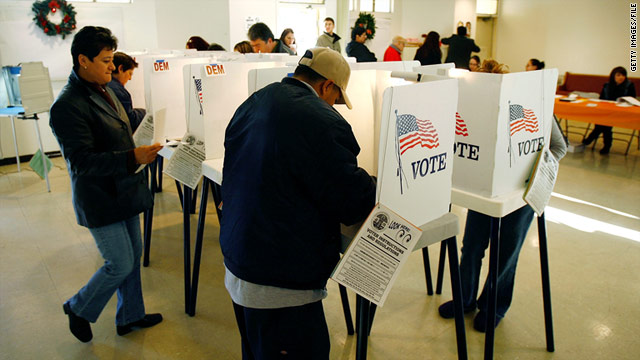
WASHINGTON — For decades, Hispanic voters have been seen as a key voting bloc of the future, and the latest census show how quickly the future is arriving. Hispanic people have accounted for more than half of all U.S. population gain since 2010.
But “the Hispanic vote” is a harder thing to nail down. When you look closely, it looks less like a consistent “bloc” and more like other groups of voters. That is, increasingly, it looks as though different outside factors can have big influences on how Hispanics act in the voting booth.
Start with the exit poll results from 2020. At a national level, the story seems pretty clear. Hispanics are a big and important Democratic constituency. (The exit polls and the Census Bureau organize their demographic groups differently. The exit polls ask people whether they are “Latino.” The census relies on the category “Hispanic or Latino.”)
Nationally, the Latino vote made up about 13 percent of the total ballots cast last year, and Democrat Joe Biden won the group by 33 points.
But the numbers start to look a little different when you break them down at the state level.
In California, the Latino vote is massive (it represented almost a third of all votes cast last year), and it gave Biden a huge 52-point advantage. In New York, the Latino vote was even more solidly Democratic, giving Biden a 54-point edge.
But the numbers look different in Texas, where Biden had a smaller 17-point edge. And in Florida, where the Hispanic vote swings more widely, Biden won it by only 7 points.
The Latino vote in Florida is markedly different because of the nature of the population. Cubans are the largest Latino group in the state, and there are also large numbers of Venezuelans and Colombians. All those countries have suffered under communist regimes, and many immigrants from those places are leery of “socialism” in the U.S.
In a broader sense, some of the more basic rules of U.S. voters also seem to apply to Hispanics. Urban and suburban Latino voters are solidly Democratic in the exit polls, but the numbers shift in rural communities.
In urban and suburban areas nationally, Biden held a big advantage with Latino voters, winning them by more than 30 points.
The numbers look very different in rural areas. Biden still held an advantage, but it shrank to 15 points, less than half what it was in urban and suburban communities.
For people familiar with politics, the urban/rural split is familiar. It’s also apparent among white voters, although with a greater divide. Last year, Democrats won among urban whites narrowly and lost among rural whites by large margins.
Still, the split among Latino voters is noteworthy. And there are signs of the differences in the county-level vote last year.
Census data show that 234 counties around the country have populations that are 30 percent or more Hispanic. In many of those locales, former President Donald Trump did better last year than he did in 2016 — particularly in rural communities and Miami-Dade County, Florida, which many ethnic Cubans, Colombians and Venezuelans call home.
rump lost ground in 21 of the 234 counties, meaning he got smaller percentages of the vote last year than he did in 2016. But Trump gained ground in 194 of them, and in 24 he had big gains of 10 points or more.
What do those 24 counties look like? Most are rural and near or along the Mexican border, and 21 of them are in Texas. Miami-Dade is also in there, by far the most populous location.
To be clear, those are just counties with large Hispanic populations. We can’t say for certain whether Hispanic voters drove the shifts in them; however, it seems fairly clear that the Hispanic vote was the key factor in many of the counties because of their demographics. In 20 of the 24, the population is more than 70 percent Hispanic.
The point is that the “Latino vote” or the “Hispanic vote” is clearly growing, but as it grows it may also be changing. Hispanics were once mostly adding to the U.S. population through immigration, but that’s no longer true. Since 2000, most of the nation’s Hispanic population growth has come from births, not immigration.
And as the roots of Hispanic and Latino populations grow in the U.S. through generations, it may be that they are less and less following the patterns of “the Hispanic and Latino voters” and increasingly following the patterns of “U.S. voters.”



Be the first to comment